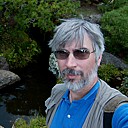Wesley R. Elsberry

Posts: 4991
Joined: May 2002
|
I agree that a DSLR is the way to go if you really want to get some wildlife photos.
I have DSLRs that take Nikon lenses, primarily because I already had Nikon lenses. Currently, I have a Nikon D2Xs and a Fuji S2. The D2Xs has speed and endurance going for it. It is built like a tank and weighs like one, too. It does 5 frames per second at the full 12 megapixel size, and 8 frames per second in a 6.7 megapixel "crop mode". The Fuji S2 design dates back to 2002, and will shoot at a leisurely 2 frames per second. It is considerably lighter than the D2Xs. But both work fine with the lenses, including my Nikkor 70-200mm f/2.8 VR lens.
My in-laws recently were burgled, and their camera gear stolen. They find weight a major consideration. So I suggested that they look at some of the Four-Thirds system DSLRs. The Four-Thirds system is designed around a sensor size that is comparable to the APS-c sensor in my Nikon cameras. But because the whole system is designed to that spec, the cameras are smaller, and the lenses can be smaller and lighter.
As with any photography, plan to spend any money on a camera body that can do the job you want, and more money on a good lens or lenses. Your lens purchase is likely to last you decades. Your digital camera to use that lens? Probably not.
Most cameras are bundled with a "kit" lens. Standard fare these days is something around a 3x mid-range zoom, with a f/3.5 - 5.6 maximum aperture. Optically, these range all over the map. Some have excellent, if somewhat slow, optics. Others combine mediocre speed with mediocre resolution. For pretty much any camera you get, there will be available a fixed focal length "standard" lens that is fast, tack-sharp, and relatively cheap. For Nikon, that lens is the Nikkor-AF 50mm f/1.8. With the 1.5x crop factor considered that applies to all Nikon DX sensor cameras, it is like using a 75m lens on a film 35mm SLR. If you can set up the camera with a remote, this sort of lens can do the trick. Most of the time for wildlife work, though, a longer lens is needed.
You'll find that most systems offer essentially two grades of lenses. There are relatively inexpensive lenses with modest maximum apertures offered for the mass market, and pro-quality lenses with terrific resolution and large maximum apertures, with pro-level price tags. Both Canon and Nikon have this sort of split in the lens inventory. I have a Nikkor G 70-300mm f/4 - 5.6 lens that cost me a little over $100. It does nicely from 70 to about 250mm, especially if I can stop down at least two f-stops from the maximum. At the long end, resolution noticeably drops off. I also have a "AF-S VR Zoom-NIKKOR 70-200mm f/2.8G IF-ED" lens. The alphabet soup describes various features. AF-S is Nikon's advanced in-lens focusing motor system, one that is both fast and quiet. VR is "vibration reduction", an in-lens system that moves around optical elements to counter the small movements everybody makes when hand-holding a lens. IF is for "internal focusing", where focusing happens by movement of sub-groups of optics in the lens, and not simple displacement of the optics via a helicoid. ED is for "extra-low dispersion", which means at least one element of glass in the lens has a particular composition that has much better dispersion characteristics than standard crown glass. This lens has five such elements. It also cost about $1,600 more than the 70-300mm lens. Is the price difference worth it? It depends. I have been able to get excellent images with the 70-200mm that would have been impossible to get with the 70-300mm. And the image quality is stunning. In comparison to a 105mm prime lens I have from way back, the 70-200mm holds its own, and the 105mm is one that is generally considered one of the sharpest lenses Nikon ever made.
So my advice is to figure out which lens is going to do the job you want, then pick the camera to match. That's how I got started with SLRs way back when. My photo mentor, Lamar Philpot, spotted an excellent used Nikkor-AI 24mm f/2.8 lens for sale at a good price and pointed it out to me. It was my first purchase of 35mm SLR gear, and it took me another couple of months to get a Nikon F2 to put it on. I still have the 24mm f/2.8 lens, though not that first Nikon F2.
Edited by Wesley R. Elsberry on Mar. 19 2009,15:23
--------------
"You can't teach an old dogma new tricks." - Dorothy Parker
|


















